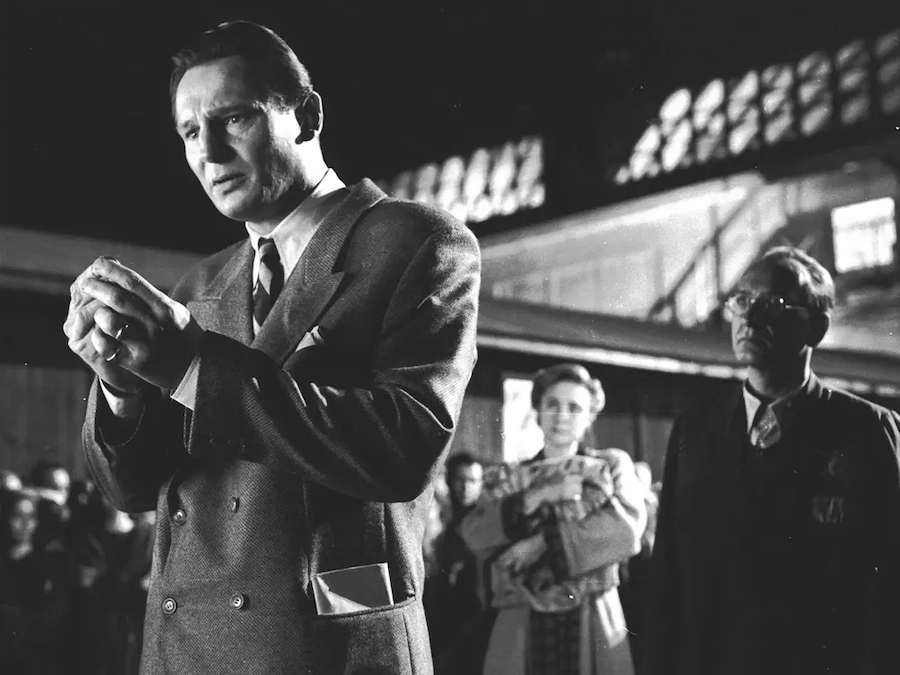
THE LIST IS LIFE. THE MAN WAS REAL. THE STORY IS TRUE.

In 1993, Schindler’s List was a seminal event, one of those things you simply had to experience. I was in school and every student was treated to a showing of the film, as part of a campaign to teach children about the Holocaust. Undeniably one of the finest films ever made about this grim period, it is bound to age with grace and teach new generations about the horrors of Nazism long after the last victims have died.
Shooting in Krakow
Steven Spielberg became familiar with Thomas Keneally’s novel at an early stage, but thought he lacked the experience to make the movie. So he waited, but in the early months of 1993 found himself shooting the film in Krakow, Poland. Sure, he had just made Jurassic Park, which was not very different from Jaws (1975), but by then he knew that he had nevertheless reached a level of maturity sufficient to make this consequential film. It all begins in that Polish city in September, 1939.
The German businessman Oskar Schindler (Liam Neeson) sees an opportunity to make money off the war. He strikes a deal with Jewish businessmen whose financial support makes it possible for Schindler to open an enamelware factory, helping the war effort. The accountant Itzhak Stern (Ben Kingsley) provides Schindler with cheap labor: Jews who would otherwise be sent to various camps.
The enterprise is successful, but things change with the arrival of SS officer Amon Goeth (Ralph Fiennes). The ghetto is razed and Goeth builds a concentration camp, Plaszow; Schindler manages to keep his workers by bribing Goeth. As the war draws to a close, Goeth is ordered to send his prisoners to Auschwitz and Schindler feels compelled to take more risks to save his workers, the “Schindlerjuden”.
Making it look like a documentary
Three fascinating hours go by easily as we follow the plight of the Schindler Jews, surviving the bloody purge of the Krakow ghetto, the insane whims of Goeth who enjoyed shooting prisoners from the balcony of his villa in Plaszow, and the near-annihilation of those workers who were mistakenly transported to hell on earth, Auschwitz. Spielberg and cinematographer Janusz Kaminski shot this unrelenting film in black and white, an effort to make it look like old WWII documentaries. There are plenty of haunting images, including some with color tints that stand out, such as a girl’s red dress and the lighting of candles.
Ralph Fiennes is an eye-opener in his breakthrough as the thoroughly evil Goeth
John Williams’s music is a magnificent achievement in itself, a superbly touching score, made even more gripping thanks to violinist Itzhak Perlman. Neeson gives one of his most impressive performances as we follow Schindler’s journey from selfish, fun-loving war profiteer to dedicated humanitarian; Kingsley is equally good as his careful, hardworking bookkeeper. Fiennes is an eye-opener in his breakthrough as the thoroughly evil Goeth; his eyes are cold, but you can nevertheless sense the human being, his dreams and desires. Unfortunately, they aren’t pretty.
After the war, 1,200 Jews owed their lives to Schindler’s manipulation of the system and the film ends with survivors and their descendants visiting his grave in Jerusalem, putting stones on it according to the Jewish faith. An emotional way to say goodbye to a real hero, but sentimentality never cramps this masterpiece. It has a refreshing sense of humor, in the face of death. Whether you survived or not was mostly up to luck, what kind of mood your tormentors were in. Death was random in those godforsaken times.
Schindler’s List 1993-U.S. 195 min. B/W-Color. Directed by Steven Spielberg. Screenplay: Steven Zaillian. Novel: Thomas Keneally (”Schindler’s Ark”). Cinematography: Janusz Kaminski. Music: John Williams. Editing: Michael Kahn. Art Direction: Allan Starski. Cast: Liam Neeson (Oskar Schindler), Ben Kingsley (Itzhak Stern), Ralph Fiennes (Amon Goeth), Caroline Goodall, Jonathan Sagalle, Embeth Davidtz.
Trivia: Co-produced by Spielberg. At different stages, Billy Wilder, Sydney Pollack and Martin Scorsese considered directing the film; Spielberg offered it to Roman Polanski, who (having survived the Holocaust himself) didn’t feel ready to do it. Warren Beatty was considered for the lead role; Dustin Hoffman as Stern.
Oscars: Best Picture, Director, Adapted Screenplay, Cinematography, Score, Editing, Art Direction-Set Decoration. Golden Globes: Best Motion Picture (Drama), Director, Screenplay. BAFTA: Best Film, Supporting Actor (Fiennes), Adapted Screenplay, Cinematography, Score, Editing.
Quote: “This list… is an absolute good. The list is life. All around its margins lies the gulf.” (Kingsley)
Last word: “I wasn’t sure if I could get a script developed from the book. The book didn’t have a narrative that was obvious to the naked eye. It was full of names, facts, dates and times – certification of authenticity. The great mystery, though, which I could never solve when I read it, was: Why did Schindler do this? Why did he risk his life and spend 95 percent of the money he’d amassed to buy his workers back from Amon Göth and eventually bring them to freedom? Every time I look at my Rosebud sled hanging on the wall, I think, ‘I never had the Rosebud moment for Schindler’s List that Orson Welles found for Citizen Kane.’” (Spielberg, The Hollywood Reporter)
